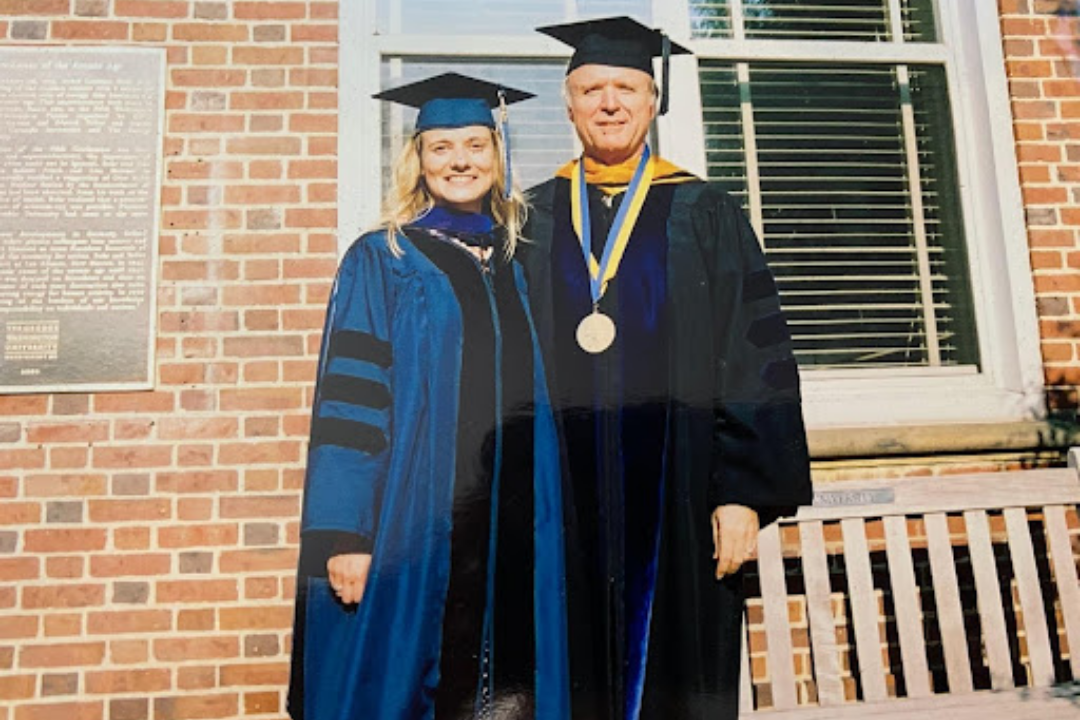When Maggie Teliska, PhD ’04, recalls her time as a chemistry student in GW’s Columbian College of Arts & Sciences, she doesn’t immediately think about her many accomplishments—like her innovative work on fuel cell technology, her numerous published academic papers or her rigorous lab work at sites from the Naval Research Laboratory to Brookhaven National Laboratory.
Instead, Teliska focuses on the strong, personal connections she made at GW—connections that helped forge her path forward. She talks about her lifelong friendships with fellow alumni, many of whom work in the energy field, and the faculty mentors who laid the foundation for her success: Professor of Chemistry David Ramaker, who passed away in 2016, and Chemistry Professor Emeritus Michael King.
“GW is a great place to be a scientist,” she said. “I had access to great faculty, world class facilities and leaders in government research labs. Best of all, my fellow graduate students became my family.”
Teliska’s studies set her on a wide-ranging career path in sustainable energy. She recently joined the innovation leadership team at Enel Green Power, one of the world’s leading renewable energy companies. Through her job, she is also actively mentoring others, including Trip Johnson, a second-year master’s student in Columbian College’s Environmental & Green Chemistry Program, who worked as a summer intern at Enel. In addition, she serves as a board member for the nonprofit Women’s Energy Network, where she helps foster careers for women in energy industries.
“It’s so great to see the breadth of Maggie’s contributions,” said Chemistry Department Chair Christopher Cahill, a professor of chemistry and international affairs. “She did some great science while here at GW, has clearly made her mark in industry and is a force for empowering women and the next generation of STEM.”
Throughout her professional career, Teliska has focused on designing and developing power sources. She has worked with academia, the federal government and companies from tech startups to established manufacturers. At Enel, she scouts innovative technologies that improve sustainability and efficiency at power generation sites. She will even appear as an artist’s rendering of a STEM superhero in an upcoming children’s book on female scientists called Everyday Superheroes: Women in Energy.
“Maggie’s enthusiasm for science as well as her ability to share her knowledge and communicate her unbridled excitement about what she is working on are without parallel,” said King, who retired in 2020 after a 50-year-career at Columbian College. “She has carried the passion we saw as a graduate student forward in a career that has been filled with many stunning achievements.”
At Enel, Teliska’s energy expertise connects with Johnson’s green chemistry studies. As an intern, Johnson worked with Teliska on agrivoltaics projects, which involved developing models for using solar power in agriculture. While Johnson hopes to work in environmental and energy policy after graduation, the internship allowed him to learn more about the industry aspects of sustainability, he said. Like other students in the green chemistry program, Johnson is combining coursework and real-world experience to meld the science of environmental chemistry with energy policy, public health and business perspectives.
“The program is tailored to deliver careers outside of academia,” said Jakub Kostal, assistant professor of chemistry and co-director of the green chemistry program. “We help students apply their unique technical toolbox in a context of decision-making frameworks that are relevant to future employers.”
Teliska initially planned to pursue a biotechnology degree at GW but was inspired by Ramaker’s quantum chemistry course to switch her research interests. “It was pretty terrifying at the time,” she laughed. “But there was a heavy math component and I was always good at math so I gave it a shot.”
While her chemistry studies were rewarding—she was the lead author on four peer-reviewed publications, won two teaching awards and made a significant discovery to maximize fuel cell performance—Teliska said faculty like Ramaker and King made the most lasting impacts on her life. “They weren’t just professors. They were mentors. I was so incredibly lucky to have worked with them.”
Like Teliska, Johnson envisions himself continuing the tradition of aiding chemistry department students in their careers—whether he ultimately works in industry, research or on Capitol Hill. “I've been able to benefit from GW alumni. The least I can do is help another chemistry student when the shoe is on the other foot and I’m in the professional world.”


